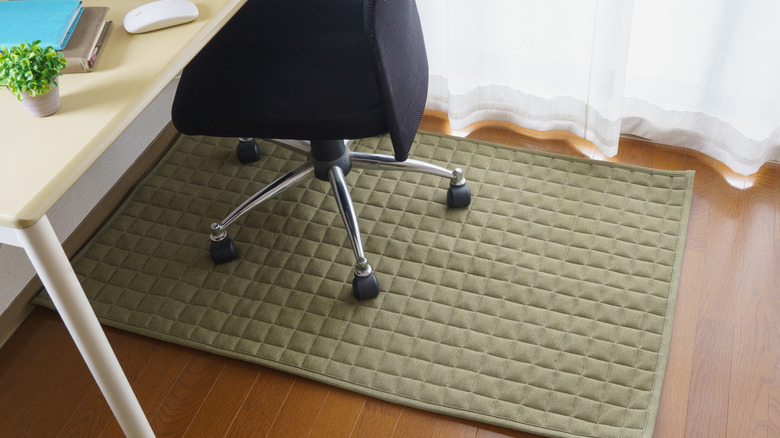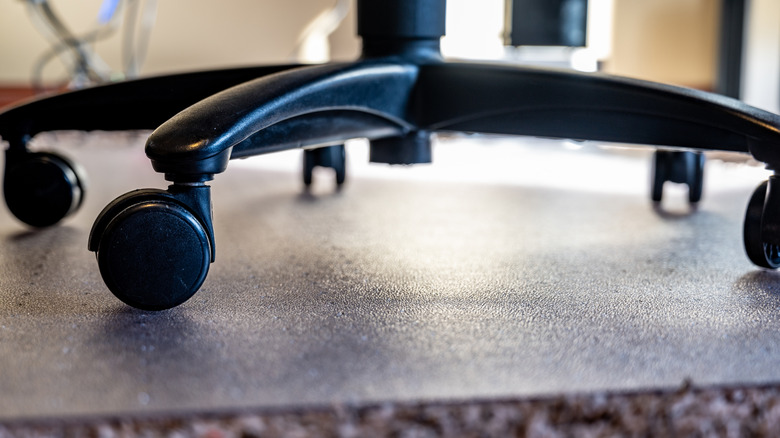Chair Mat Vs Rug: Which Is The Right Option For Your Home Office Floor?
We may receive a commission on purchases made from links.
Picking the right chair mat or rug for your home office involves a lot of different choices, including cost, functionality, and style. Chair mats, which are usually made out of vinyl, bamboo, or tempered glass, provide a hard surface which is designed to protect your floors, as well as allow easy chair movement. These often feature cleats underneath to grab onto carpet, or non-slip coatings for hardwood floors. Rugs, however, offer a nicer visual aesthetic but may require more maintenance to keep them flat and chair-friendly.
The choice of which works for you should come down to floor type and work habits. Chair mats work well with carpeted floors for better stability and movement, while hard floors can use either without much issue. You also need to know how thick your carpet is as standard mats can work fine on low-pile carpet, but if you have shag or high-pile carpet you should consider premium, thicker materials. If style is your priority, rugs allow better color choices and texture but may wear out faster over time. Rugs are also the softer option, which is nice for families with kids or pets, and they can keep your wheeled chair from rolling around too much.
Safety and performance over time
New chair mats often take time after unrolling to lay flat; using weights on the corners at first can help, but some might require tape to prevent curling. A high-quality mat should last around five to seven years with proper care and offers more protection to your floors. There are some quick and easy ways to flatten your new rug, but a rug's durability relies on its material; polypropylene, for instance, can resist wear and stains better than natural fibers.
For safety, mats typically include anti-static properties, which is important when working with electronics. Rugs, while generally slip-resistant, can generate static and might become a tripping hazard if the edges start to lift. They do excel in noise reduction, though, which can be helpful when working around others for long periods. If you often have allergies, mats are easier to keep clean, but there are some simple tricks to deep-cleaning your rugs. Your office chair's wheels can impact this choice as well. Hard plastic casters can easily gouge unprotected hardwood but roll smoothly on a mat. Rubberized wheels can work well on either a mat or a low-pile rug. The modern rollerblade-style wheels are more narrow which works best with carpet but could create permanent indentations in thinner rugs and mats over time.
Cost, style, and flexibility options
As far as cost goes, mats tend to be more affordable, with some basic models such as the Kuyal chair mat starting around $30. Quality rugs can be a bit pricey but offer many more design choices; from nature-inspired prints to modern geometric patterns, there are a ton of style options to fit your space. Cost also depends on the size of the mat you might require, as different desk areas have different needs. Make sure to measure your work area based on how much room you need to roll around. Mats can benefit from having a lip at the top, allowing it to fit easily under your desk space. Larger rugs can be used to encompass the entire desk area, leaving less need for specific dimensions.
Hybrid solutions are also an option; placing a small clear mat for your chair over a larger rug helps protect it from constant use. Clear or glass mats are also useful for those who prefer the look of their hardwood floors and just want to add some protection but generally go for premium prices. However, their non-porous surfaces can help resist stains better than standard PVC mats when dealing with spills, making the premium price a little more justifiable. Choosing darker-colored rugs can also help hide the wear and tear that chair wheels can cause. Either way, it's important to test out each option and see what works best for you and your space.


